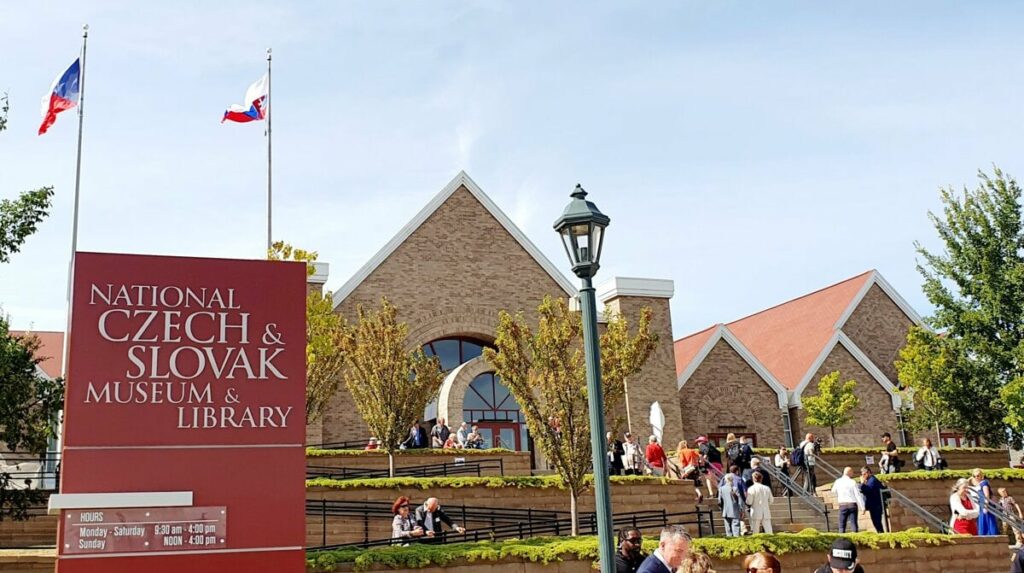Andrej Haršány, a Slovak artist, has hand-sculpted a dozen 1.2 metre tall immigrant figurines for the Orloj clock in Iowa. (Source: Mark Dillon)NCSML featuring more Slovak exhibits
Haršány’s work is the latest initiative by a now globally renowned museum to showcase Slovak and Czech culture, art, heritage, and research at NCSML, under the leadership of Dr Cecilia Rokusek, president and CEO. Rokusek also serves as Slovak honorary consul for southern Florida in the U.S.
“It is truly a Czech and Slovak effort,” Rokusek says of the project. The Orloj replaces a clock tower damaged by a straight-line windstorm four years ago. Three decades earlier, in October 1995, the original tower was co-dedicated by Slovak President Michal Kováč, Czech President Václav Havel, and U.S. President Bill Clinton.
On the evening before the clock tower debut, Pellegrini also dedicated the NCSML’s incorporation of the Jankola Library into its research collection, named after Slovak-American Roman Catholic priest Rev Matthew Jankola. Meanwhile, Pavel brought around 60 guests on his presidential jet, according to the museum.
Pellegrini was also scheduled to meet with Slovak-American leaders for 45 minutes after the Orloj dedication for a forum discussion, followed by a one-hour public “political roundtable” with Pavel and various diplomats.
Until this spring, the Sisters of Saints Cyril and Methodius, an order of nuns founded by Slovak-American Rev Jankola, managed the library on their campus in Danville, Pennsylvania. Since the mid-1940s, the library has amassed one of the largest collections of Slovak and diaspora literature, history, language, spiritual works, and science holdings in North America.
The Iowa museum’s tower and collection expansion are seen by benefactors as positive affirmations of an era when more than 500,000 Slovaks emigrated to the U.S. in search of new lives, overcoming a lack of opportunity and discrimination in the Austro-Hungarian Empire. In Slovak lands, one in every five people emigrated to the U.S. between 1880 and the mid-1920s, according to the U.S. genealogy group CGSI.
The tower is named the Buresh Immigration Clock Tower, after the late Ernie Buresh, a Czech-American banker and longtime NCSML donor who contributed $250,000 USD towards the Orloj upgrade.
The Orloj dedication also coincides with the 100th anniversary of the Johnson-Reed Act, national U.S. legislation that severely restricted immigration from Central and Eastern Europe, limiting the number of immigrants from Czechoslovakia to 3,073 persons a year. (At the time, Czechoslovakia included Czechia, Slovakia, and the Carpatho-Rusyn homeland region surrounding Uzhhorod, now part of Ukraine.)
Overcoming adversity to retell the immigration story is something the NCSML knows well. In 2008, flooding of the Cedar River adjacent to the museum caused $11 million worth of damage and led the museum to relocate its main building to higher ground. The 2020 windstorm provided an insurance settlement that helped catalyse the clock tower rebuilding and expansion plan to create a functional Orloj and figurines, which were not part of the original tower.
Additional work on the four-sided tower, still in progress, includes one side featuring a stone angel, with reliefs focusing on immigration to Iowa. A Moravian artist is creating two temporary art panels—one representing Czech culture and the other Slovak culture. With further fundraising, the museum hopes to install bronze sculptures depicting immigration to replace the art panels. A sundial will also be added to the fourth side, facing the street.
Iowa can experience extreme weather, including an average of 48 tornadoes per year, with powerful winds and hail. The region receives about a metre of snow each winter, and average daily temperatures are below freezing from December to February.
Haršány arrived in Iowa on September 15 to help install the figurines with the assistance of a construction crew and museum volunteers, and he hopes his woodwork can withstand the test of time and climate change.
“We’ve done everything we can to protect them,” he noted.
Source link : http://www.bing.com/news/apiclick.aspx?ref=FexRss&aid=&tid=66fbf78e8dc64254ad8b916efb558c3f&url=https%3A%2F%2Fspectator.sme.sk%2Fc%2F23391904%2Fslovak-artists-immigrant-figurines-debut-in-iowas-new-clock-tower.html&c=6592615190923165823&mkt=de-de
Author :
Publish date : 2024-10-01 06:17:00
Copyright for syndicated content belongs to the linked Source.
